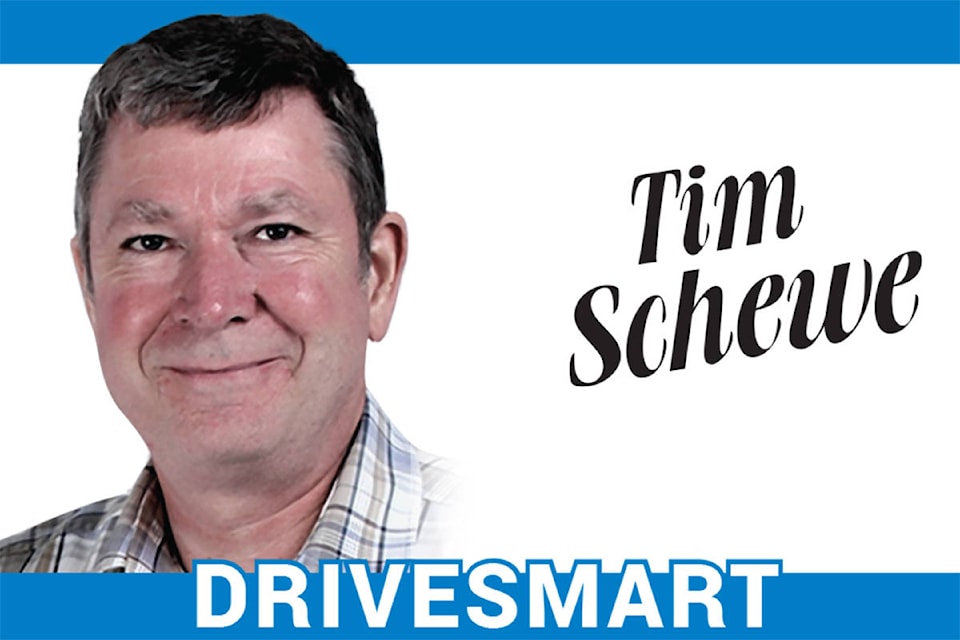By Tim Schewe
“I am thinking about upgrading the sealed beams on a vintage car to LED headlights. The LED headlights I’m considering are marked ‘DOT SAE’ on the front. Does that mean that they are legal on roadways in B.C.?” The gentleman that posed this question also supplied a web site URL with more information that promised DOT approval and explained that these lights were used by international Baja racing teams. Sounds good, doesn’t it?
I looked carefully at the picture of the light on the web site. Not only did it say DOT and SAE on the lens, it also had the European E marking. The trouble is, these are usually exclusive in my experience. The lenses are either DOT/SAE approved or carry the E mark, but not both.
What was missing is the type designation that goes with the DOT/SAE marking to tell what function the light fulfilled.
At this point I was convinced that the headlight replacement that this person wanted to buy was not a wise purchase. Just to be sure, I drew on the expertise of Dan Stern, a vehicle lighting expert and Editor in Chief of Driving Vision News. Did this headlight meet standards?
His response was no, and it’s not a headlamp, it’s a headlite-shaped trinket, one of a mountain of them. It’s a pathetic knockoff of the legitimate headlamps made by JW Speaker.
This headlamp does not actually bear any safety certification or approval marks. It has fraudulent partial markings specifically designed to falsely assure buyers who cannot reasonably be expected to spot the difference.
More generally: it is very easy to get bogged down in “What about this one? How about this one? I saw this other one, is it OK? It says DOT, that makes it OK, right?” types of endless loops. Fact is, there are only a very few legitimate brands of LED headlamps to replace standard-size round and rectangular halogen or sealed-beam lamps. With the widest possible inclusion (meaning these are legitimate lamps, not necessarily excellent ones) they are, in no particular order:
Truck-Lite
JW Speaker
Peterson
Maxxima
HiViz
Grote (rebranded Maxxima)
GE (rebranded Truck-Lite)
Sylvania Zevo (rebranded Peterson)
Philips (rebranded Truck-Lite)
Harley-Davidson Daymaker (rebranded JW Speaker)
On a closely related note: the “LED bulbs” now flooding the market are not a legitimate, safe, effective, or legal product. No matter whose name is on them or what the vendor claims, these are a fraudulent scam. A halogen lamp — any halogen lamp — equipped with one of these will not produce an appropriate, proper, safe, or legal distribution of light.
Same goes for “HID kits” in halogen-bulb headlamps or fog/auxiliary lamps (any kit, any lamp, any vehicle no matter whether it’s a car, truck, motorcycle, etc.). The particulars are different for LED vs. HID, but the principles and problems are the same overall.
There is a task force within the Society of Automotive Engineers Lighting Systems Group working to devise a technical specification for LED retrofit bulbs for use in halogen lamps. There are tall technical challenges to making such a retrofit bulb that actually works acceptably, and such retrofit bulbs are still several years away. When they become available, the situation will actually be more complicated than it is today, because then consumers will have to discern between legitimate and fraudulent LED bulbs: “some of them are OK and others aren’t”.
For now, the situation is comparatively simple: halogen lamps need to use halogen bulbs or they don’t (can’t, won’t) work effectively, safely, or legally. This is not like trying out different bulbs in the kitchen or living room or garage, where all it has to do is light up in a way you find adequate and pleasing. Headlamps aren’t just flood or spot lights; they are precision optical instruments (yes, even a cheap and minimal headlamp counts as a precision optical instrument) that have a complex, difficult job to do in terms of simultaneously putting light where it’s needed, keeping it away from where it’s harmful, and controlling the amounts of light at numerous locations within the beam to appropriate levels (too much light in certain areas is just as dangerous as not enough). Headlamps cannot just spray out a random blob of light, and that’s what they do with anything other than the correct kind of light source.
“Legal” is a bit of a slippery target in Canada, because Canada Motor Vehicle Safety Standards do not adequately regulate the aftermarket. There are stringent standards that apply to headlights and bulbs installed by a vehicle maker as original equipment, but those national standards aren’t written so as to allow Canada Border Services Agency to stop the flow of unsafe aftermarket lighting equipment into Canada. However, for several reasons this does not make an anything-goes situation; provinces and territories can still enact vehicle equipment requirements, and many of them require vehicles used on public roadways to have lighting equipment that complies with the applicable Canada Motor Vehicle Safety Standards (namely: 108 and/or 108.1). Furthermore, even if one happens to live in a place where the vehicle equipment code is silent on the matter, or is laxly enforced, there can be severe liability consequences to using unsafe lights. After a crash, if a vehicle is found to have lights that don’t meet the standard, and that is even potentially a contributing factor in the crash, the owner of the vehicle stands to get absolutely hosed in court, and could face ruinous liability costs. So grinning and saying “Well, it’s not illegal in my province” or “Well, the cops don’t care” is foolhardy.
Nevertheless, even major brands (Philips, Sylvania) have taken advantage of the outdated limitations in the national standards to market what they claim are LED retrofit bulbs for halogen headlamps. It’s unfortunate that they’re allowed to profiteer this way.
Tim Schewe is a retired constable with many years of traffic law enforcement. To comment or learn more, please visit DriveSmartBC.ca
